Agricultural Sciences
Vol.4 No.8A(2013), Article ID:35977,5 pages DOI:10.4236/as.2013.48A003
Ecophysiological response to irrigation of two olive cultivars grown in a high-density orchard
![]()
Department of Agricultural and Environmental Sciences, University of Bari Aldo Moro, Bari, Italy; *Corresponding Author: salvatore.camposeo@uniba.it
Copyright © 2013 G. A. Vivaldi et al. This is an open access article distributed under the Creative Commons Attribution License, which permits unrestricted use, distribution, and reproduction in any medium, provided the original work is properly cited.
Received 21 May 2013; revised 22 June 2013; accepted 17 July 2013
Keywords: Leaf Water Potential; Stomatal Conductance; Net Assimilation; Water Use Efficiency
ABSTRACT
High-density oliveculture system needs irrigation and introduces new cultivars in new environments. So the evaluation of varietal ecophysiological response to irrigation is a crucial topic. For this reason it was planned a research on two cultivars, Coratina and Arbequina, trained according to high-density system. In 2009 the irrigation was conducted according to the conventional management by applying an irrigation frequency of 4 days. The leaf water potentials reached values similar to the limits reported for the recovery within 48 hours. However, plants showed a leaf water status and gas exchange recovery just after 24 hours from watering. The results highlighted some varietal differences: Arbequina showed a better response to irrigation, while Coratina performed a higher water use efficiency by a lower leaf transpiration.
1. INTRODUCTION
The diffusion in recent years in the world of oliveculture high-density system has led to an intensification of studies on its irrigation management, as this plays an important role in determining the agronomic sustainability of this farming system [1,2]. In fact, unlike the traditional oliveculture systems, crop irrigation is indispensable in order to obtain an optimal and constant production level in high-density oliveculture [3-5]. There are three cultivars on which, up to now, has been calibrated this system: two Spanish, “Arbequina” and “Arbosana”, and one Greek “Koroneiki” [6,7]. The introduction of new cultivars into new environments raises the necessity to evaluate their eco-physiological behaviour in response to irrigation. It has been shown that with the irrigation olive tree can recover water status and optimal leaf gas exchange within 2 - 3 days only if water stress imposed in pre-irrigation determines values of leaf water potential higher than −1.0 MPa and −2.5 MPa at pre-dawn and midday, respectively; at lower values the recovery is much slower (twenty days); under −2.0 MPa and −4.0 MPa, respectively, it does not take place at all [8-13].
In order to investigate the ecophysiological responses to irrigation a long-term research on two olive cultivars grown was started according to the high-density system: Arbequina and Coratina. This paper reports the effects of the conventional irrigation management.
2. MATERIALS AND METHODS
The study was carried out in the olive grove located at the experimental farm of the Department of Agricultural and Environmental Sciences at Valenzano (Bari, Southern Italy—41˚01'N; 16˚45'E; 110 m a.s.l.), on a sandy clay soil (sand, 630 g·kg−1; silt, 160 g·kg−1; clay, 210 g·kg−1) classified as a Typic Haploxeralf (USDA) or Chromi-Cutanic Luvisol (FAO). The site is characterised by a typical Mediterranean climate, with a long-term average annual rainfall of 560 mm, two third concentrated from autumn to winter, and a long-term average annual temperature of 15.6˚C. The olive grove was planted in 2006 with plant spacing of 4.0 m × 1.5 m (1667 trees·ha−1) according to the Spanish high-density system. Props, drip irrigation and routine cultural practices (nutrition, pruning, disease control) were set up as already described [3,6]. The research was conducted on two cultivars: Arbequina, on which the high-density system was calibrated, and Coratina, the most important traditional Apulian olive cultivated variety [14]. In 2009, the irrigation management was carried out according to the conventional criteria, restoring the soil water reserve easy available when exhausted. From June to September, monthly measurements were carried out just before irrigation (pre irrigation) and 24 hours after irrigation (post irrigation). Between 11:00 am and 1:00 pm under light saturation conditions (PAR ≥ 1800 μmol photons m−2·s−1), for each cultivar on healthy, well-exposed mature leaves, placed in the middle part of the fruiting branches of three plants, were measured: stomatal conductance (gs; molH2O m−2·s−1), transpiration (E; mmolH2O m−2·s−1) and the net assimilation (A; μmolCO2 m−2·s−1), with an open-system portable gas analyzer (model LCA-4, Analytical Development Company, Ltd., UK) and a leaf chamber PLC4-B. The water use efficiency (WUE = A/E) was normalized with the air water vapour pressure deficit (VPD, kPa). On the same leaves and at the same time leaf water potential (ψmd) was measured; on the nearest leaves pre-dawn leaf water potential (ψpd) was measured. On the same day soil water potential (ψs) was measured of a soil sample extract at 40 cm in depth between two adjacent trees. The time of irrigation has been managed following the evolution of the soil water potential, making measures every three days. All leaves and soil potentials were measured by a psychrometer chilled mirror (model WP-4T, Decagon Devices, Inc., USA). All data were subjected to statistical analysis using the SAS program (V9.1) for MS Windows (SAS Institute Inc., USA); significant parameters to the F-test (P ≤ 0.05) were analyzed with the post hoc SNK test.
Considering the strong influence of climatic factors on irrigation management, the 2009 climatic pattern has been monitored at the agro-meteorological station located in the same experimental farm and supplied by the Agro-meteorological office of the ASSOCODIPUGLIA. The long-term climatic data (1974-2004) were recorded at the closest station to the site under study and obtained from the Central Bureau of Agricultural Ecology. The average monthly temperatures were identical to those of the long-term values (15.6˚C). The total rainfall, on the contrary, was much higher than the long-term values (+365 mm); however most of the rainfall occurred outside of the irrigation season, during which the rainfall was a little lower than the thirty-year values.
3. RESULTS AND DISCUSSION
3.1. Climatic Pattern
During the irrigation season from June to September 2009 (Figure 1), monthly mean temperatures were quite similar to that of the thirty-year value (23.2˚C vs 22.5˚C as mean, respectively). Rainfall values of June and September resulted higher than that of thirty-year mean (48.6 mm vs 38.2 mm in June and 67.1 mm vs 54.8 mm in September, respectively). On the contrary in July and
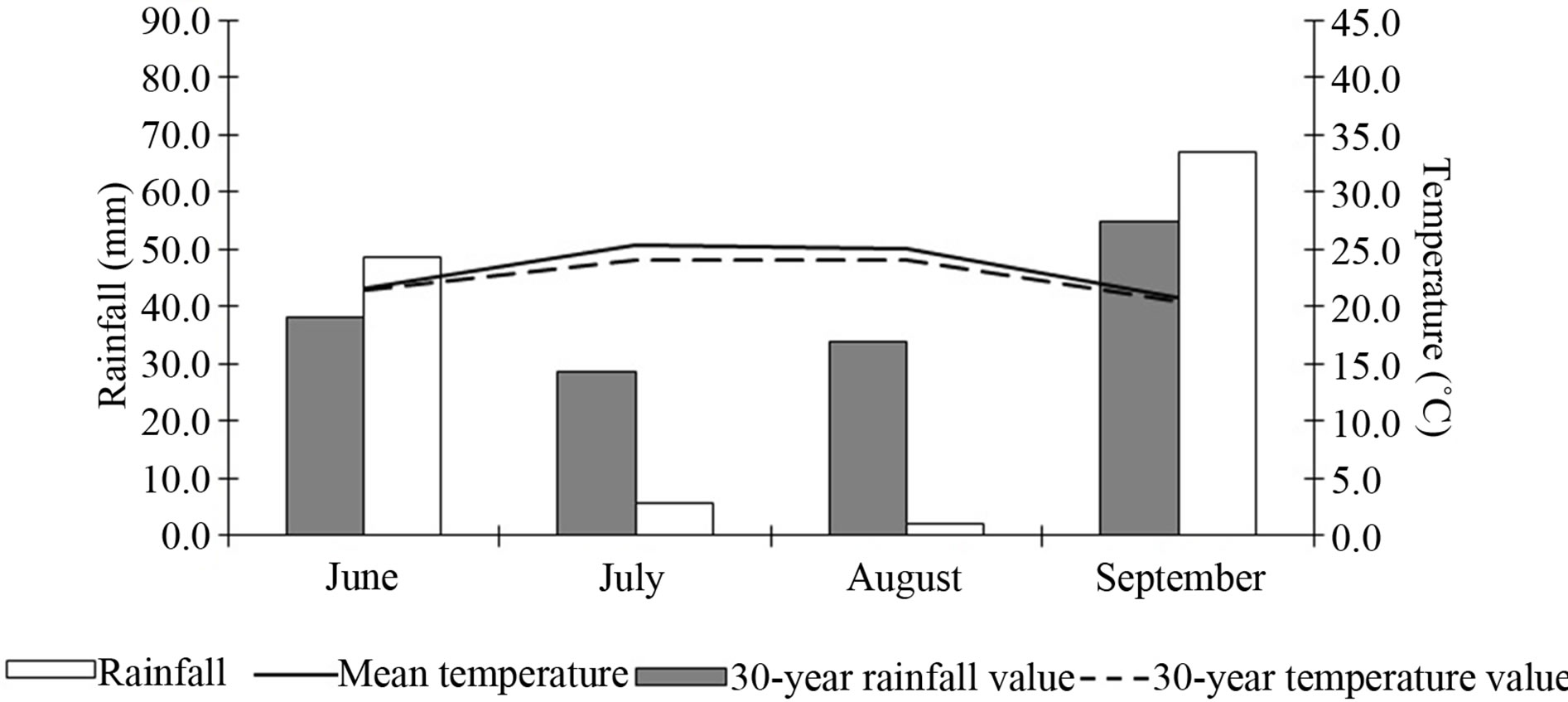
Figure 1. Rainfall and temperature during experimental period (2009).
August it rained much less than the thirty-year mean (5.6 mm vs 28.7 mm in July and 2.2 mm vs 34.0 mm in August, respectively). So the climatic pattern strongly influenced seasonal ecophysiological pattern.
3.2. Seasonal Pattern
During the irrigation season (June-September) both cultivars showed in general statistical differences between pre and post irrigation for all the ecophysiological parameters (Figures 2 and 3).
For cv Arbequina ψmd decreased significantly both in pre irrigation (from −2.9 MPa to −3.6 MPa) and in post irrigation (from −2.6 MPa to −3.2 MPa) moving from June to other months, when unchanged, in response to the rainfall lack. At the same time gs dropped from 0.06 molH2O m−2·s−1 to 0.03 molH2O m−2·s−1 in pre irrigation while unchanged in post irrigation (0.07 molH2O m−2·s−1 as mean). A decreased from 5.4 μmolCO2 m−2·s−1 in June to 3.4 μmolCO2 m−2·s−1 in the rest of the irrigation season and from 6.3 μmolCO2 m−2·s−1 to 4.3 μmolCO2 m−2·s−1, in pre and in post irrigation, respectively. On the contrary WUE unchanged during irrigation season in pre irrigation (6.8 μmolCO2 kPa mmolH2O−1 as mean) while in post irrigation it increased from 6.1 to 8.3 μmolCO2 kPa mmolH2O−1 from June to September. The conventional irrigation always significantly increased ψmd and gs in post irrigation with respect to pre, except gs in June, due to the abundant rainfall. A did not increase in August and September after irrigation and WUE did not change from July to September.
For cv Coratina the ψmd showed a very similar behaviour to that of cv Arbequina, decreasing significantly from −3.5 MPa to −3.9 MPa in pre treatment and from −3.1 MPa to 3.6 MPa in post treatment moving from June to other months. Similarly gs decreased in pre irrigation from 0.07 molH2O m−2·s−1 to a value of 0.03 molH2O m−2·s−1, and from 0.07 molH2O m−2·s−1 to 0.05 molH2O m−2·s−1 in post irrigation. A had the same trend in both pre and post irrigation: the values decreasing from 5.8 μmolCO2 m−2·s−1 to 2.7 μmolCO2 m−2·s−1 and from 7.1 μmolCO2 m−2·s−1 to 3.8 μmolCO2 m−2·s−1, respectively. Finally WUE decreased during the irriga-
 (a)
(a) 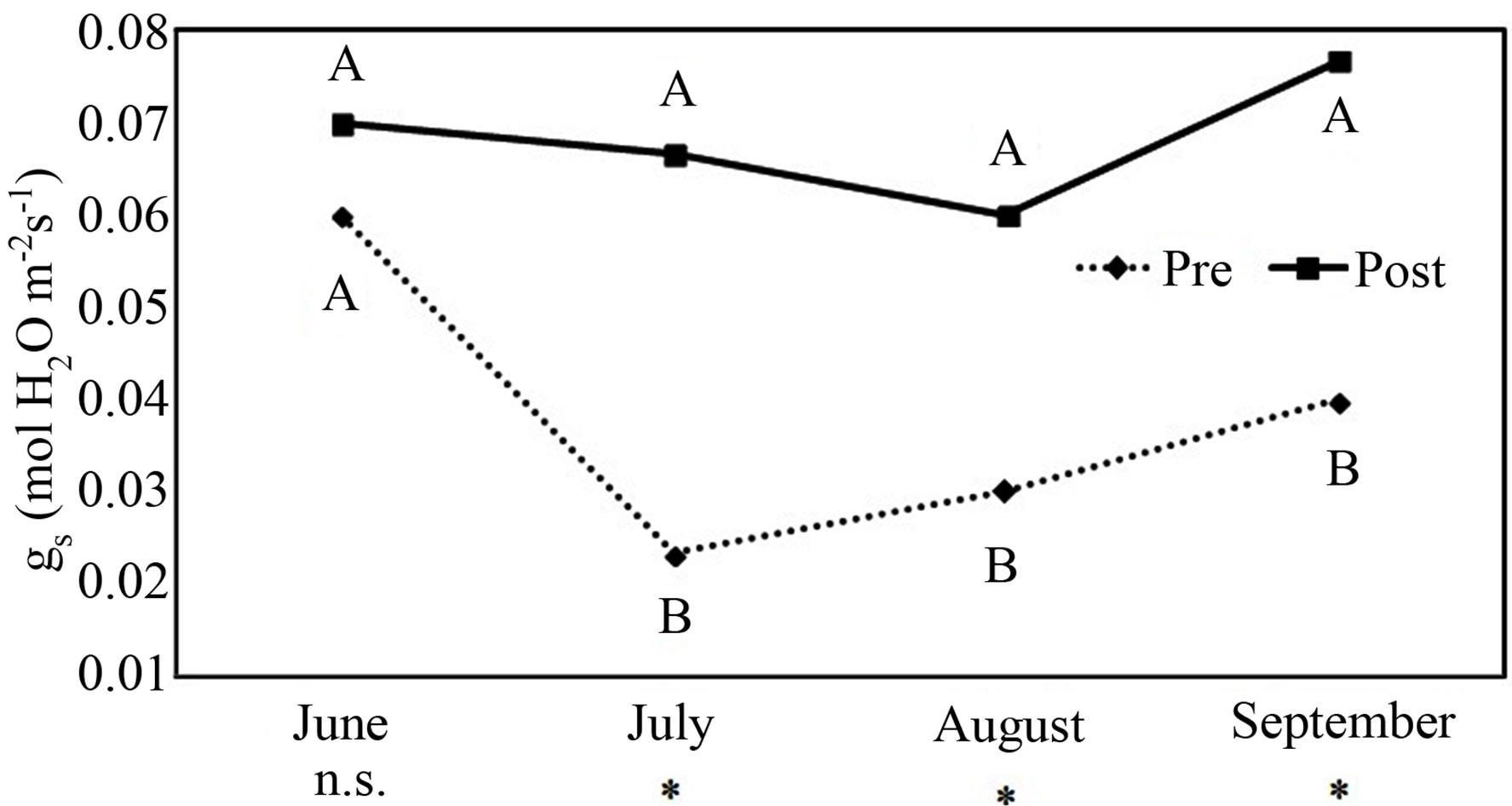 (b)
(b) 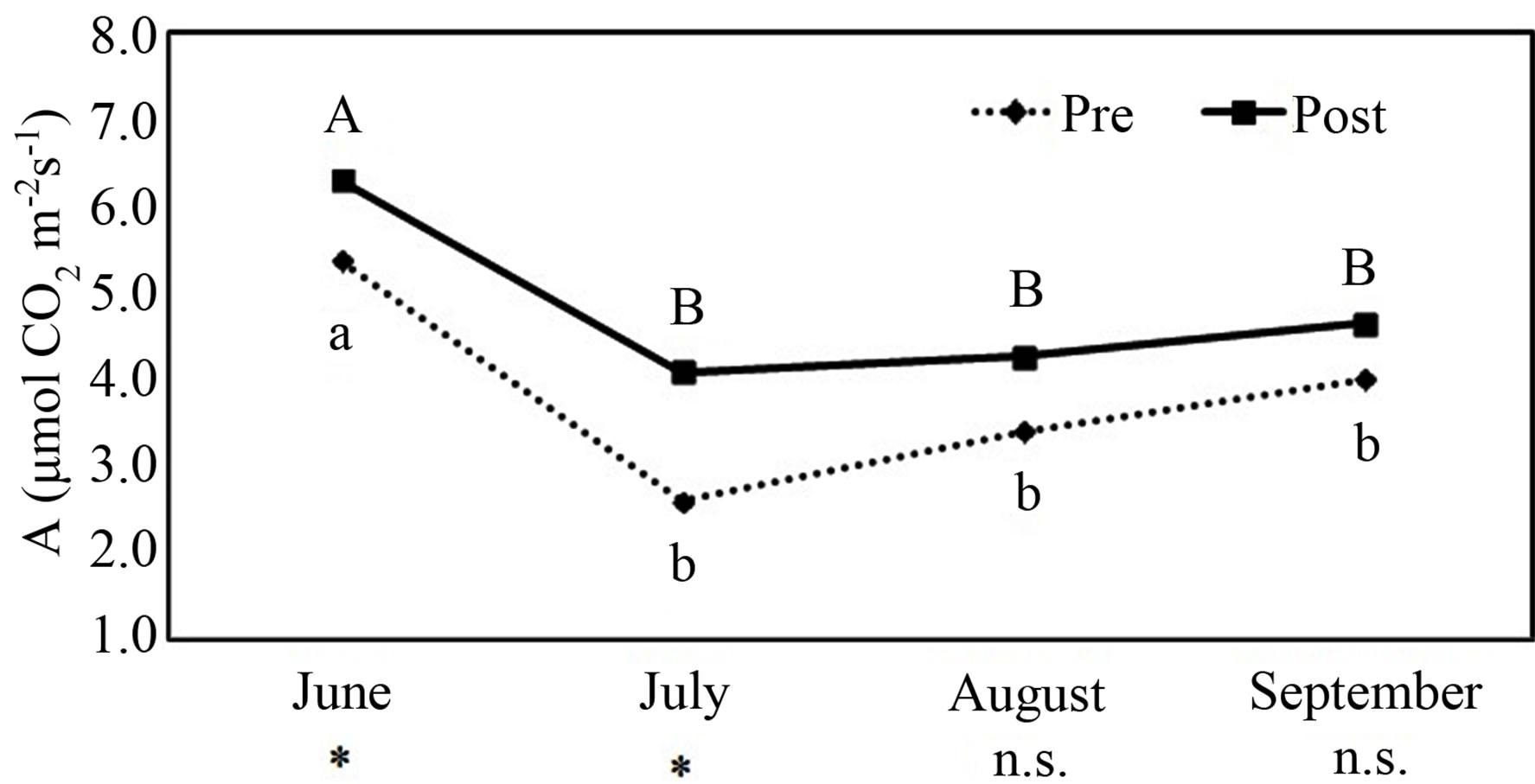 (c)
(c) 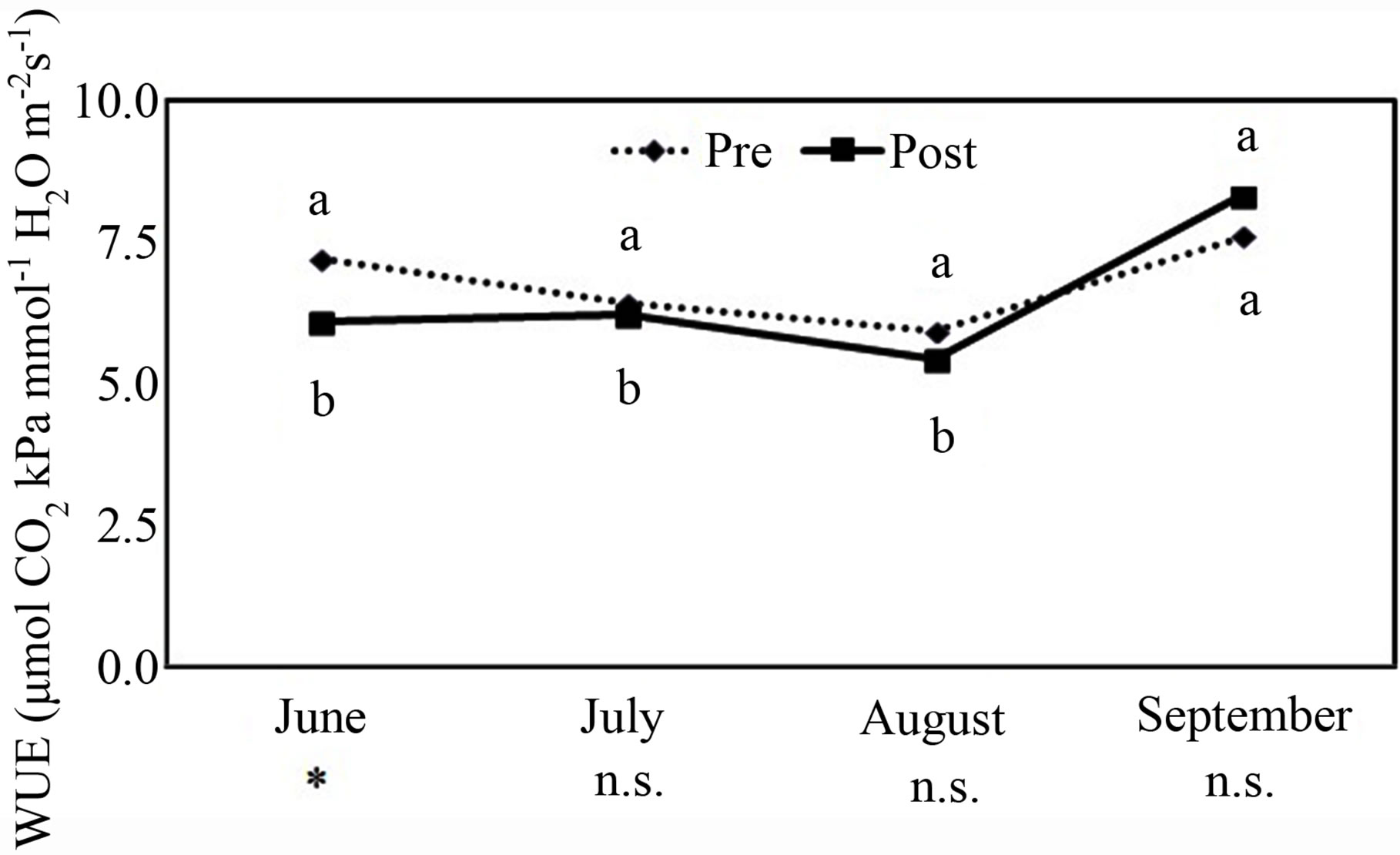 (d)
(d)
Figure 2.Seasonal pattern of leaf water potential (ψmd, MPa; a) stomatal conductance (gs, molH2O m−2·s−1; b) net assimilation rate (A, μmolCO2 m−2·s−1; c) and normalized water use efficiency (WUE, μmolCO2 kPa mmolH2O−1; d) in pre irrigation (Pre) and post irrigation (Post) of cultivar Arbequina during irrigation season 2009. The letters denote statistical differences among different times within each curve (SNK test; lower case letters for p ≤ 0.05, capital letters for p ≤ 0.01). The symbols on the x-axis denote statistical differences between pre and post irrigation for each time (t test, *p ≤ 0.05, n.s. not significant).
 (a)
(a) (b)
(b) (c)
(c)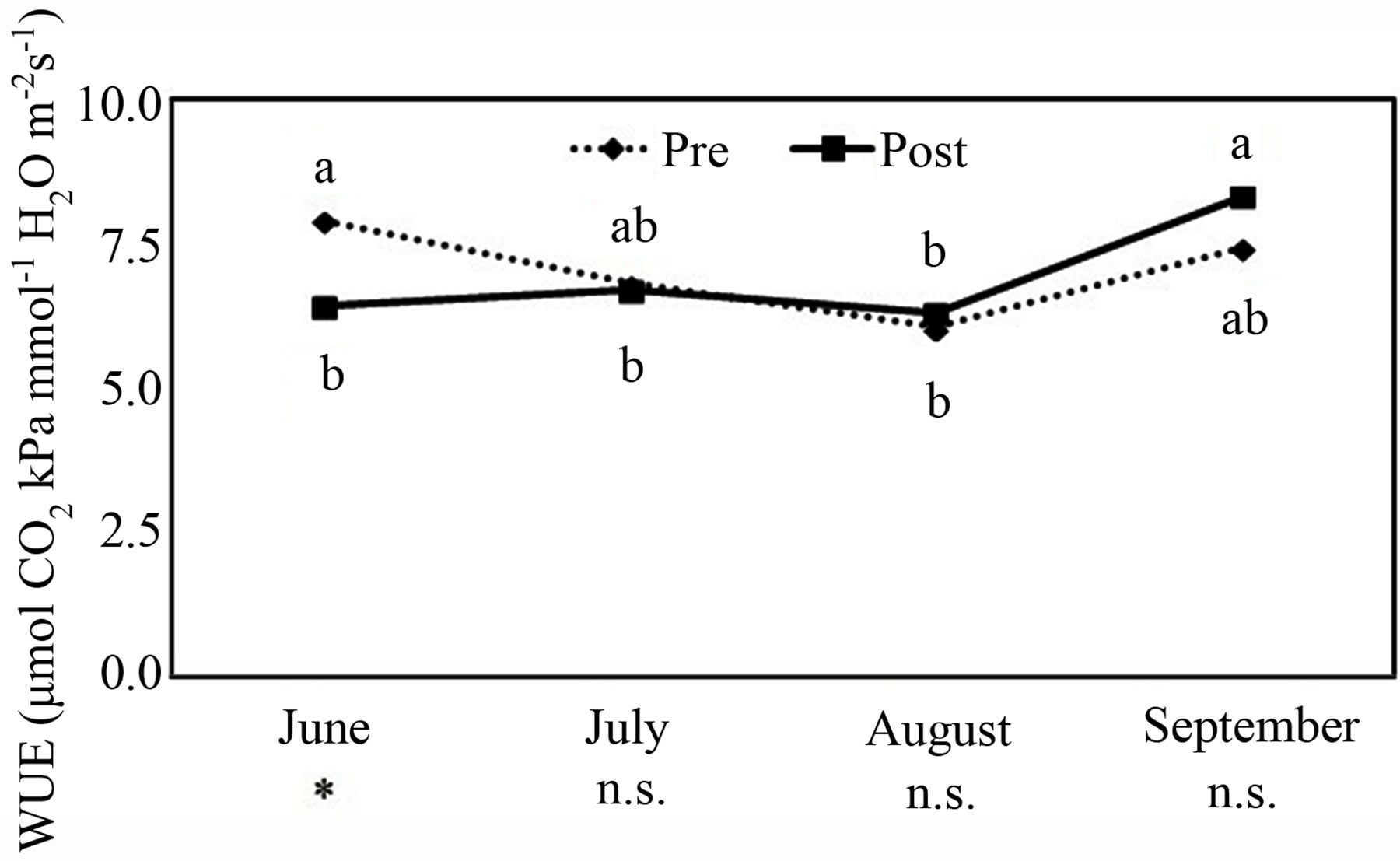 (d)
(d)
Figure 3. Seasonal pattern of leaf water potential (ψmd, MPa; a) stomatal conductance (gs, molH2O m−2 s−1; b) net assimilation rate (A, μmolCO2 m−2 s−1; c) and normalized water use efficiency (WUE, μmolCO2 kPa mmolH2O−1; d) in pre irrigation (Pre) and post irrigation (Post) of cultivar Coratina during irrigation season 2009. The letters denote statistical differences among different times within each curve (SNK test; lower case letters for p ≤ 0.05, capital letters for p ≤ 0.01). The symbols on the x-axis denote statistical differences between pre and post irrigation for each time (t test, **p ≤ 0.01, *p ≤ 0.05, n.s. not significant).
tion season in pre irrigation from 7.8 μmolCO2 kPa mmolH2O−1 to 6.7 μmol CO2 kPa mmolH2O−1, but increased in post irrigation from 6.4 μmolCO2 kPa mmolH2O−1 to 8.3 μmolCO2 kPa mmolH2O−1. As Arbequina did, the conventional irrigation always significantly increased ψmd and gs in post irrigation with respect to pre, except gs in June, A did not increase in September after irrigation and WUE did not change from July to September. These ecophysiological values are very similar to those reported in the same environment and for the same cultivars [2]. The general reduction in A and the scarce effect of the irrigation in the last months of the season is stated in the literature for olive cultivars, in relation to senescence of leaves [15]. The WUE lack of significance is due to its conservative behaviour [16].
3.3. Genotype Effect
With the conventional irrigation, ψs values moved from −0.54 MPa (irrigation threshold) to about field capacity (ψs = −0.07/−0.08 MPa; Table 1).
Not significant differences in the ψpd (−1.89 MPa pre irrigation and −1.57 MPa post irrigation) were observed between cultivars for each measurement and between measurement for each cultivar (Table 1). In contrast, significantly more negative ψmd values both in pre and post irrigation of cv Coratina compared to cv Arbequina were observed: −4.08 MPa vs −3.40 MPa in pre irrigation and −3.68 MPa vs −3.10 MPa in post, respectively (Table 1). No statistical difference was obtained for ψmd between measurements for each cultivar (Table 1). The leaf water potential values obtained are lower than those allowing a rapid recovery of gas exchange, according to the literature. After irrigating gs showed an improvement trend for both cultivars, even without statistical differences among cultivars: 0.04 molH2O m−2·s−1 in pre irrigation and 0.07 molH2O m−2·s−1 in post irrigation, as mean (Table 1). The E has not shown statistical differences between pre/post irrigation for each cultivar and no statistical difference among cultivars for each measurement; nevertheless Coratina showed lower stomatal transpiration than Arbequina in post irrigation (2.55 mmolH2O m−2·s−1 vs 2.82 mmolH2O m−2·s−1, Table 1). For both cultivars irrigation significantly increased the A: from 3.64 to 4.82 μmolCO2 m−2·s−1 for Arbequina, from 3.54 to 4.72 μmolCO2 m−2·s−1 for Coratina, in pre and post respectively; no varietal difference was observed (Table 1). Finally, in post irrigation Coratina showed higher WUE (7.18 μmolCO2 kPa mmolH2O−1) compared to Arbequina (6.15 μmolCO2 kPa mmolH2O−1) (Table 1).
This work contains the first data of the evolution of ecophysiological parameters for these two cultivars grown according to the high-density system: in fact, other works were already carried out on other cultivars obtaining values significantly different as a function of cultivar and climate and soil characteristics [17].
4. CONCLUSION
Under conventional irrigation management on the seasonal basis leaf water potential of both cultivars did not increase significantly after irrigation, in spite of a significant improvement of the soil water status, confirming the anisohydric behaviour of olive tree. The leaf water potential values were lower than those allowing a rapid recovery of gas exchange, according to the literature; irrigation determined an increasing stomatal conductance and transpiration trends and a significant increase in net assimilation of both cultivars, already 24 hours after irrigation, in spite of a not significant improvement of the leaf water status. On the montly basis the conventional irrigation always significantly increased

Table 1. Soil water potential (ψs), leaf water potential (ψmd) and leaf gas exchange at midday (stomatal conductance gs; leaf transpiration E; net assimilation rate A; normalized water use efficiency WUE) and pre-dawn leaf water potential (ψpd), before (pre) and after (post) irrigation of cultivar Arbequina and Coratina (2009 mean values, ±standard error). The first letter denote statistical differences between pre/post irrigation values for each cultivar, the second letter denote statistical differences between cultivars for each date (t-test, p = 0.05).
leaf water potential and stomatal conductance in post irrigation with respect to pre, while net assimilation did not increase in August and September after irrigation in relation to senescence of leaves and water use efficiency did not change from July to September due to its conservative behaviour. Finally Arbequina always showed best values of leaf water potential and a better recovery of gas exchange than Coratina that showed a better water use efficiency than Arbequina, likely for a lower transpiration. These data are very useful for irrigation management of olive cultivars grown in new environments and in new cropping systems.
5. AKNOWLEDGEMENTS
This research had the financial support of the National Research Program (PRIN-MIUR, Project “Biological processes and environmental factors involved in the vegetative growth, fruiting and oil quality control in superintensive olive (Olea europaea L.) plantings”.
REFERENCES
- Gomez-del-Campo, M. (2007) Effect of water supply on leaf area development, stomatal activity, transpiration, and dry matter production and distribution in young olive trees. Australian Journal of Agricultural Research, 58, 385-391. doi:10.1071/AR06178
- Camposeo, S. and Vivaldi, G.A. (2011) Short-term effects of de-oiled olive pomace mulching application on a young super high-density olive orchard. Scientia Horticulturae, 129, 613-621. doi:10.1016/j.scienta.2011.04.034
- Camposeo, S., Ferrara, G., Palasciano, M. and Godini, A. (2008) Varietal behaviour according to the superintensive olive culture training system. Acta Horticulturae, 791, 171-274.
- Godini, A., Vivaldi, G.A. and Camposeo, S., (2011) Olive cultivars field-tested in super high-density system in southern Italy. California Agriculture, 65, 39-40. doi:10.1016/j.scienta.2011.04.034
- Strippoli, G., Vivaldi, G.A., Camposeo, S. and Contò, F. (2013) Sprouts seasonal elongation of two olive cultivars in a high density orchard. Agricultural Sciences, 4.
- Camposeo, S. and Godini, A. (2010) Preliminary observations the performance of 13 varieties according to the super high density olive culture training system in Apulia (southern Italy). Advanced Horticultural Science, 24, 16-20.
- Camposeo, S., Vivaldi, G.A. and Gattullo, C.E. (2013) Ripening indices and harvesting times of different olive cultivars for continuous harvest. Scientia Horticulturae, 151, 1-10. doi:10.1016/j.scienta.2012.12.019
- Angelopoulos, K., Dichio, B. and Xiloyannis, C. (1996) Inhibition of photosynthesis in olives trees (Olea europaea L.) during water stress and rewatering. Journal of Experimental Botany, 47, 1093-1100. doi:10.1093/jxb/47.8.1093
- Fernàndez, J.E., Moreno, F., Giròn, I.F. and Blàzquez, O.M. (1997) Stomatal control of water use in olive tree leave. Plant and Soil, 190, 179-192. doi:10.1023/A:1004293026973
- Alegre, S., Marsal, J., Mata, M., Arbones, A., Girona J. and Tovar M. (2000) Regulated deficit irrigation in olive trees (Olea europaea L. cv. Arbequina) for oil production. Acta Horticulturae, 586, 259-262.
- Moriana, A., Villalobos, F.J. and Fereres, E. (2002) Stomatal and photosynthetic responses of olive (Olea europaea L.) leaves to water deficits. Plant, Cell and Environment, 25, 395-405. doi:10.1046/j.0016-8025.2001.00822.x
- Iniesta, F., Testi, L., Orgaz, F. and Villalobos, F.J. (2009). The effects of regulated and continuous deficit irrigation on the water use, growth and yield of olive trees. European Journal of Agronomy, 30, 258-265. doi:10.1016/j.eja.2008.12.004
- Sofo, A., Dichio, B., Montanaro, G. and Xiloyannis, C. (2009) Shade effect on photosynthesis and photoinhibition in olive during drought and rewatering. Agricultural Water Management, 96, 1201-1206. doi:10.1016/j.agwat.2009.03.004
- Camposeo, S., Ferrara, G., Palasciano, M. and Godini, A. (2012) About the biological behaviour of cv. Coratina. Acta Horticulturae, 949, 129-133.
- Proietti, P., Nasini, L. and Ilarioni, L. (2012) Photosynthetic behaviour of Spanish Arbequina and Italian Maurino olive (Olea europaea L.) cultivars under super-intensive grove conditions. Photosynthetica, 50, 239-246. doi:10.1007/s11099-012-0025-7
- Steduto, P. and Albrizio, R. (2005) Re source use efficiency on field-grown sunflower, sorghum, wheat and chickpea. II. Water use efficiency and comparison with radiation use efficiency. Agricultural and Forestry Meteorology, 130, 269-281. doi:10.1016/j.agrformet.2005.04.003
- Gomez-del-Campo, M. (2010) Physiological and growth responses to irrigation of a newly established hedgerow olive orchard. Horticultural Science, 45, 809-814.

